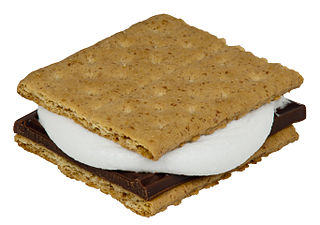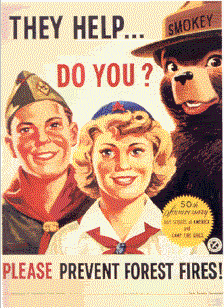
Camp Fire, formerly Camp Fire USA and originally Camp Fire Girls of America, is a co-ed youth development organization. Camp Fire was the first nonsectarian, multicultural organization for girls in America. It is gender inclusive, and its programs emphasize camping and other outdoor activities.

A s'more is a confection consisting of toasted marshmallow and chocolate sandwiched between two pieces of graham cracker. S'mores are popular in the United States and Canada, and traditionally cooked over a campfire.

A camporee is a local or regional gathering of Scouting units for a period of camping and common activities. Similar to a camporee, a jamboree occurs less often and draws units from the entire nation or world. It should not be confused with the Australian term "jamborette".

Daniel Carter "Uncle Dan" Beard was an American illustrator, author, youth leader, Georgist and social reformer who founded the Sons of Daniel Boone in 1905, which Beard later merged with the Boy Scouts of America (BSA).

Treasure Island is a former Boy Scout property located between Point Pleasant, Pennsylvania and Frenchtown, New Jersey, United States. The property is situated on two islands in the middle of the Delaware River and was owned by the Cradle of Liberty Council. Treasure Island was the second oldest continually operated Boy Scout Camp, behind Owasippe Scout Reservation in Michigan, in the country and had been continuously associated with Scouting since 1913.

Scouting in Maine dates back to the creation of the Katahdin Area Council in 1920 and has continued prominently to the present day.

Scouting memorabilia collecting is the hobby and study of preserving and cataloging Boy Scouting and Girl Guiding items for their historic, aesthetic and monetary value. Since collecting depends on the interests of the individual collector, the depth and breadth of each collection varies. Some collectors choose to focus on a specific subtopic within their area of general interest, for example insignia issued prior to the 1970s Boy Scouts of America requirement that all insignia have either the fleur-de-lis or the acronym BSA; or only the highest ranks issued by each nation. Others prefer to keep a more general collection, accumulating any or all Scouting merchandise, or Scouting stamps from around the world.

Since Scouting began in 1907, it has entered into many elements of popular culture, including movies, TV and books.

The Golden Gate Area Council (GGAC) is a council of the Boy Scouts of America, formed by a merger of the San Francisco Bay Area Council, Alameda Council, and the Mount Diablo Silverado Council in June 2020. GGAC is one of the five councils that serves the San Francisco Bay Area in California. GGAC includes the counties of Alameda, Contra Costa, Lake, Napa, San Francisco, southern Solano, and the northernmost portion of San Mateo.

The Mid-America Council of the Boy Scouts of America offers programs in 58 counties in Nebraska, Iowa and South Dakota. The Mid-America Council was formed from a merger of the Covered Wagon Council and the Southwest Iowa Council in 1965. The first recorded Council in the area was in 1918 as the Omaha Council. In 2000 the council merged with the Prairie Gold Council that had been located in Sioux City, Iowa.

Mount Diablo Silverado Council was a local council of the Scouts BSA and was one of six councils that serves the San Francisco Bay area in California. The council's office was located in Pleasant Hill, California. It served chartered organizations and BSA units in Contra Costa County, Lake County, Napa County, Solano County, and the cities of Albany and Berkeley in northern Alameda County. The council is located in BSA Western Region Area III. It merged with Alameda Council #021 and San Francisco Bay Area Council #028 in June 2020 to form the Golden Gate Area Council #023.

The Little Sioux Scout Ranch is a 1,800-acre (730 ha) Scout reservation owned by the Gilwell Foundation and operated by the Mid-America Council of the Boy Scouts of America. It is located in Little Sioux, Iowa, about sixty miles north of Omaha, Nebraska in Iowa's Loess Hills and 15 minutes east of Interstate 29.

Three Harbors Council is a local council of the Boy Scouts of America serving three southeastern Wisconsin counties: Milwaukee County, Racine County, and Kenosha County. Its name and logo refer to the three major port cities of Milwaukee, Racine, and Kenosha on Lake Michigan.

The South Florida Council is a 501(c)(3) organization chartered by the Boy Scouts of America to serve Broward, Miami-Dade, and Monroe Counties in South Florida. As of 2022, the South Florida Council had a membership of more than 20,000 youth and adults in traditional and in-school and after-school programs. The South Florida Council is Platinum rated charity by Guidestar and a Four out of Four-star rated charity by Charity Navigator.
South Plains Council serves Scouts in the area of Lubbock, Texas.

The Scoutmaster is a 1956 painting by American illustrator Norman Rockwell. It was originally created by Rockwell for the 1956 Brown & Bigelow Boy Scout Calendar. Since then, it has become one of the most collected images that Rockwell created for the Boy Scouts of America.

Rex D. M. Hazlewood was a long-serving official of The Boy Scouts Association of the United Kingdom and was its editor of The Scout and The Scouter magazines and author of articles, pamphlets and books on Scouting.

The Campfire ash ceremony is a ritual associated with Scouting meant to convey the long history and fellowship associated with the movement. Attributed to Lord Baden-Powell, it is said that he would take a small amount of the ashes from the campfire he was at, and would take them to add to the next campfire he attended.

Valdemārs Klētnieks, also known as Voldemārs Klētnieks and Valdis Klētnieks, was a Latvian writer and national Scout Commissioner for Latvia before World War II. When the Soviet Union occupied Latvia in 1940, the Latvian Scout Organization was banned. Klētnieks eventually fled Latvia for a displaced persons camp in Germany, where he remained for five years following the end of World War II. In 1950, he settled with his wife and children as refugees in the United States, where he continued to write books in the Latvian language and joined the Boy Scouts of America national staff.


















